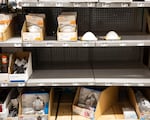On Feb. 28, before many Oregonians had any idea of how fundamentally their lives were about to change, Oregon’s public health officials presented confident resolve to anyone concerned about the coronavirus.
"Oregon has proven its resiliency in preparing for and responding to Ebola, H1N1 influenza, Zika, and other global public health threats," Oregon Health Authority director Pat Allen said in a statement announcing the creation of a new Coronavirus Response Team. "If the coronavirus comes to Oregon, we will be ready."
Mere hours after that statement went out, Oregon’s first known case of COVID-19 was detected in a Lake Oswego school employee. Nearly two weeks later, after the virus had cropped up throughout the state and taken root in a home for elderly veterans, the certitude had vanished.
“We find ourselves in an unprecedented public health crisis,” Brown said on Thursday, March 12, as she announced a statewide ban on gatherings of more than 250 people. “Most of us have never experienced anything like this. What is clear today is that we must take immediate action to stem the spread of COVID-19 coronavirus.”

The first presumed case of coronavirus in Oregon was diagnosed in an employee at Forest Hills Elementary in Lake Oswego.
Meerah Powell / OPB
Health officials speaking after Brown would lay out a chilling scenario: They say there are likely hundreds of existing cases undetected in Oregon currently, with more than 75,000 cases possible by May without quick, strong action. That's a number that could spur enough serious cases to easily outstrip Oregon's health care resources.
“This virus,” state epidemiologist Dr. Dean Sidelinger said at the time, “does not discriminate.”
Depending on who you talk to, what happened between those two dates — from the doorstep of Oregon’s travails with the pandemic that has rocked American life, to the moment officials most candidly acknowledged we are losing the battle with the disease — looks very different.
Some believe that officials have done everything they could to grapple with a situation that is unprecedented in modern times. Others say dithering — largely by federal officials, but with inconsistent decision making by the governor and public health agencies — has risked lives.
“The bottom line is that the Oregon Health Authority’s and governor’s office’s response has been unsatisfactory,” Dr. Maxine Dexter, a Portland physician who has pushed for more urgent action, said Thursday. “There’s a lack of coordinated effort that is really undermining our ability to respond in a coordinated and patient-centered way.”
Others in Dexter’s line of work are more charitable.
“I think the state is doing everything right,” state Sen. Elizabeth Steiner Hayward, also a physician, said on Wednesday before concern over COVID-19 increased dramatically. “I would be jumping up and down and screaming if I thought otherwise."
Varied opinions are to be expected in a pandemic situation where even the nation's top health officials have struggled to respond. In recent days, the United States has been subject to increasing criticism for not acting urgently to stem the spread of the virus.
But right or wrong, the state’s response has sometimes felt erratic in the last two weeks, with seemingly firm decisions quickly reversed with little notice.
The list of examples grows by the day.
On March 3, shortly after Washington Gov. Jay Inslee asked for $100 million in state funding to attempt to fight his state’s already-worrisome epidemic, Oregon’s governor and her staff offered assurances that Oregon agencies had enough local resources. They sent a letter to Vice President Mike Pence asking for an array of protective equipment and supplementary funding, but appeared confident in the face of a handful of local cases.
Brown’s staff also said at the time that an emergency declaration, which Washington state had also issued, would serve little purpose here.
Not everyone was so sure.
“I went to the governor twice and asked her [about needing more funding],” said Senate President Peter Courtney, D-Salem, on March 3. “She says, ‘Well I'm not gonna ask for anything at this time.’ I said, ‘Well alright.’ If this thing starts to go, and it's starting to go, the Legislature's going to have to get involved.”
On March 7, as cases of COVID-19 continued to climb, Brown issued an emergency declaration, in part citing similar moves by the World Health Organization and federal government weeks before. The declaration has paved the way for the governor to take some of the drastic steps to promote "social distancing" that Oregon has seen in recent days.
Related: After A Dud Session, Oregon Lawmakers Agree On Emergency Spending
Two days later, on March 9, Brown's office had decided it didn't have enough money after all. It asked state lawmakers for $5 million in emergency funds to help control the virus.
Brown has also shown confidence in the state’s capacity to test for COVID-19 that has not been borne out.
When the governor first petitioned Pence for federal resources to fight the coronavirus on March 3, she made no mention of a need for tests. With just three presumptive cases of the disease detected in the state, "we did not think we had need for the kits," Brown told reporters Friday.
But with Brown's demands for federal help unheeded on March 11, and the number of cases in the state rising over 20, a second letter from the governor's office to Pence noted the state's urgent need for testing kits and supplies.
“We have been contacting this administration every single day since [March 3],” Brown said Friday, “and we have received nothing — zip, zero, nothing — from them.”
By Thursday night, the situation had reached a point that few saw coming in late February: Brown announced she was shutting down Oregon’s schools.
As with other decisions, this one came on quickly. Earlier in the day, Brown had insisted such a closure would be too burdensome on families, and would not stop the virus from spreading. By 10 p.m. she’d decided schools would be closed from March 16 through the end of the month — a stretch of time that partly overlaps with spring break for almost all Oregon schools.
The governor says that decision came at the growing behest of school superintendents. While there was consensus among school officials on Wednesday that closure would be harmful, she said, that sentiment had begun to give way to concerns over staffing shortages. Before her announcement Thursday evening, at least two school districts had voted to close, regardless of the state’s stance.
“We were extremely reluctant to make this decision,” Brown said Friday, noting again that the move would not stop the spread of COVID-19 and risks serious hardships for families.
The decision to close schools was cheered by some health care workers, who believe that every day Oregon has gone without such strict social distancing protocols has created exponential risks for people who are particularly vulnerable. While children seem to be less susceptible to the virus’ worst effects, many Oregon children either live with or come into regular contact with grandparents and other older friends and relatives. Around 9,000 of the state’s 59,000 licensed teachers are 60 years of age or older.
Dexter and a fellow physician, Smitha Chadaga, spent much of Thursday circulating a letter to Brown calling for a host of strong steps they believe the governor should take, from asking people not to leave their homes except for essential reasons, to closing schools, to setting up nursing homes specifically to deal with elderly COVID-19 patients.
Dexter and Chadaga’s letter quickly attracted support from hundreds other doctors, including, evidently, that of former Gov. John Kitzhaber. (Kitzhaber did not answer a request to confirm that he’d consented his name being added to a list of supporters.)
“There are those who will judge you as being embarrassingly over-prepared or tragically under-prepared,” the letter said. “We know which side we want you to be on — in this pandemic we cannot be over-prepared.”
For Chadaga, the letter was meant as an encouragement to Brown. In the face of what she sees as the federal government’s woeful inaction, Chadaga wanted to spur Brown to act on her own.
“We have this one shot at mitigating this,” said Chadaga, who works in Portland. “If we delay by a day or two, it’s just so much more that this virus is exposed to people.”

This undated photo provided by U.S. Centers for Disease Control and Prevention shows CDC’s laboratory test kit for the new coronavirus. (CDC via AP)
U.S. Centers for Disease Control and Prevention, via AP
As the state continued to struggle Friday to adequately ramp up access to commercial testing — that is, testing outside of the state’s Public Health Laboratory, which is reserving its limited resources for a narrow scope of patients — other groups voiced concerns as well.
“One reason we believe Oregon is a bit lower in confirmed cases [than Washington] is because testing has been so delayed,” said Rachel Gumpert, a spokeswoman for the Oregon Nurses Association, the state’s labor union for nurses.
Of particular concern to the ONA: That health care workers who are showing possible symptoms of COVID-19 have little recourse to test themselves.
“If they’re experiencing coronavirus symptoms, they haven’t been given access to test kits,” Gumpert said. “If they’re coming into hospitals and they might be carrying it, they have a risk of exposing people.”

Dust masks sit on shelves at Home Depot in Clackamas, Ore., Friday, Feb. 14, 2020. The store has run low on dust masks since the coronavirus outbreak in China.
Kate Davidson / OPB
Gumpert will get little disagreement from Brown, who in the last two days has registered increasing alarm over access to not only tests, but the protective gowns, gloves and masks that health care workers rely on to safely treat patients.
“We are not getting the equipment we need” Brown said. “We are not getting the testing resources we need. This coronavirus is exposing cracks — I actually would say canyons — in our federal health care system.”
But asked whether her administration should have been less sanguine about the virus two weeks ago, Brown was emphatic that she’s always taken it seriously. A big portion of Oregon’s current problem, she suggested, is inaction by the federal government.
“Here’s the challenge: These are unprecedented times,” Brown said. “There is not a clear road map here. On March 4 when I talked to the vice president he assured me that they would be on it and providing us resources. He said that there were stockpiles of masks.”
None of that has arrived, Brown said. And with 30 cases of coronavirus detected in the state as of Friday afternoon, just how unprepared Oregon is to handle this new crisis remains to be seen.
“I think anyone who says today that we’re doing a good job getting the word out, that we’re taking very bold steps, they shouldn’t be saying stuff like that,” Courtney, the Senate president, said on March 9. “I think this is something none of us have ever seen before. Yeah, we don’t want people to panic, but I don’t care. I don’t think that we know. Oregon doesn’t know.”
